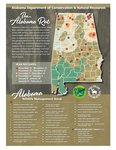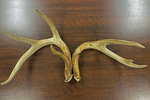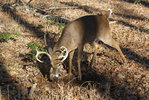While the white-tailed deer rut has come and gone in a few areas in Alabama, hunters in the majority of the state are dealing with the December doldrums, waiting for the breeding season to begin in …
This item is available in full to subscribers.
Please log in to continue |



While the white-tailed deer rut has come and gone in a few areas in Alabama, hunters in the majority of the state are dealing with the December doldrums, waiting for the breeding season to begin in earnest.
Alabama native Chuck Sykes, Director of the Alabama Wildlife and Freshwater Fisheries (WFF) Division, said the whitetails in the bulk of the state adjust to the increased activity in the woods, and hunters are having to deal with a lull in deer movement.
“People kill deer the first couple of weeks of the season, and, in my opinion, those deer get enough pressure that they go underground for a few weeks until the rut brings them back out,” Sykes said.
He said hunters should soon start seeing evidence of early rutting behavior with increased activity by the bucks.
“Typically, you’ll start seeing a few scrapes and rubs, and you’ll start seeing a few does without fawns right up under them,” Sykes said. “The does are starting to wean those fawns, getting ready for the rut. So, you’ll see button bucks walking around aimlessly by themselves.”
Bucks paw the ground to make scrapes where urine is deposited as a scent marker. A licking branch, where the buck can leave additional scent, is usually above a scrape. The rubs are the results of bucks using their antlers to debark trees, often cedars, to mark boundaries and leave more scent.
“Earlier in the season, you’ve got bachelor groups of bucks running together,” Sykes said. “You’ll see a bunch of rubs and scrapes in certain locations where they’re establishing their pecking order.
“This time of year, when you see those scrapes and rubs, it’s deer laying out their territories, getting in areas where they can intercept a bunch of does. That’s a big portion of the mating process. When you start seeing those scrapes being freshened up, those are excellent places to hunt. A scrape is like a deer nightclub. They go to it and lay down some scent. It lets everyone know who’s in the neighborhood.”
In early January, hunters will likely see a few bucks chasing does, but Sykes says that activity is only by the younger bucks.
“Those bucks usually jump the gun by a couple of weeks over your mature deer,” he said. “It’s like people who raise cows. You put a young bull in the pasture, and he’ll follow a cow around three or four days before she’s receptive, a couple of days while she’s receptive and then three or four days after she’s receptive. They waste a lot of energy.
“You put an older bull in the pasture, and he’s going to lay around until the time is right. He conserves energy. Bucks are the same way. Those young bucks are rambunctious and moving around. The mature bucks, you’re not going to see them moving until it’s right.”
As for the timing of the rut, Sykes says peak rutting activity varies very little from year to year.
“You can go back and look at our historical stocking data, and the deer rut takes place within a day or two every year in those certain locations,” he said. “When people say the deer just aren’t rutting because the weather is hot, well, the deer are still rutting. They have the ability to do it at night when the weather cools down. The rut takes place whether you see it or not.
“That’s where the environmental conditions and hunting pressure have effects. If deer are getting pressured a lot, they may not move around during daylight hours. They will wait until after dark.”
Sykes said several misconceptions about the deer rut in Alabama persist, especially with the advent of social media platforms.
“One of the biggest misconceptions is I’ve got this big buck and I’m going to save him because he’s going to breed 15 or 20 does on my property,” he said. “That’s just not the case. Whitetails are not like elk, where a bull elk might have a big harem of 10 or 15 cows. In a good year, a buck may sire four to five fawns.
“Another huge misconception that you see all the time on social media is people talking about taking this buck out of the herd because they didn’t want him breeding and passing along bad genetics. In most cases, that’s just an excuse to pull the trigger. With free-range, wild deer, culling cannot change genetics. There are just too many factors involved. Half of the genetics are coming from the doe.”
Sykes insists hunters should not try to cull bucks based on antler characteristics. Instead, cull bucks based on age.
“You need to base your decision on whether you want to feed that deer another year,” he said. “You have limited resources of food, cover and water, so that’s how you make a determination, not because of what people think are inferior genetics. If you see a buck that has a nice rack on one side and a spike on the other, more than likely that occurred because of an injury to the pedicle (antler base).”
Sykes has a long history of hunting deer in Alabama. He was a guide at Bent Creek Lodge near Jachin, Alabama, for five years before managing Circle N Lodge in east Alabama for eight years. He was a wildlife consultant for 20 years before becoming WFF Director in 2012.
“I’m kind of an oddball,” Sykes said of his deer-hunting tactics. “I like to hunt deer before the rut when I can pattern them better on food sources. The rut can be a wonderful time to hunt, and it can also be extremely frustrating. If the conditions are bad and the bucks are locked down with does, you may not see a thing. Then on that one day when all the conditions are right, you get a hot doe running through your property and you may see six or eight bucks chasing her. That’s what everybody wants to see.
“But the rut can be very hit-or-miss. It can be extremely frustrating, or it can be extremely euphoric.”
While Sykes is hunting food sources right now, when the serious rutting activity starts, he is going to areas where he can find the most females.
“In west Alabama where I spend most of my time, I’m hunting does when the rut starts,” he said. “I’m going to be in a place with as many does as I can find if I’m trying to look for a mature deer.
“There’s one thing about the rut that is fairly interesting. I’ve got 10 or 15 trail cameras out that I’ve been monitoring since June. You think you know who everybody is. You’ve got your hit list together. Then, come January 20, you’ll have a deer show up that you have no idea who he is. It could be good or bad. You have some of your regulars go see the neighbors for a few days, but their deer may come to see you.”
One of the most important factors of successful hunting during the rut is having the time to spend in the woods, which is why many hunters take significant vacation time in January.
“You can’t kill him sitting at home,” Sykes said. “You’ve got to be out there as much as possible for when the magic happens.”
However, hunters can’t be haphazard about their approach to hunting a mature buck.
“You do your homework,” Sykes said. “You do your scouting. You try to plan as much as you can. And when the conditions are right, that’s when you go.
“One of the biggest mistakes I think people make is they have a deer in an area where they have a stand, and they want to hunt him so bad that they go in with a bad wind direction or conditions that aren’t right. Typically, for those older deer, you’ve got one day you can ease in and get him. If the wind shifts or you make a mistake, it makes it 10 times harder to try to find him again. I hunt the wind. If the wind is not right, I do not go.”